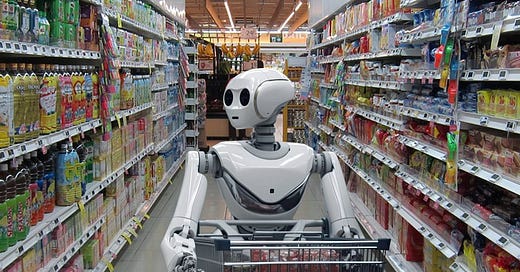Hi there and thanks for reading!
It’s been a busy few weeks for the Flabiano Fam - we celebrated my son’s first birthday, juggled a few works trips, co-hosted the annual gala for Brooklyn Greenway Initiative (a fantastic local nonprofit for which I serve on the board - check them out!) and are prepping for our first family vacation (TBD on how restful this will be). We will be headed to the Dolomites in early July for a week of hiking and birdwatching, baby in tow. Send any recommendations - and tips for flying with a baby - my way. I hope you all are enjoying your summers too.
Now on to the topic of the hour/year/decade…AI.
I’ve written a lot about how AI will shape e-commerce, introducing an adoption framework and sharing how I tested AI Operator and Perplexity’s shopping capabilities to buy things on my behalf. One thing I love about e-commerce is the dynamic nature of the industry. Technology shifts always keep things interesting - and the past year has been super interesting.
A few near-certainties are already emerging about how shopping online will change.
These have been well-documented by pretty much everyone in the space. I especially loved this recent piece from
, which speaks to several of these developments, and this one from .We will use AI answer engines - like ChatGPT, Gemini, Perplexity, Amazon’s Rufus, etc - to search for and discover products. We will be able to shop through these interfaces, and may never have to visit a brand website (unless we want to). Search is already moving to answer engines - 4% of queries are starting here, and that will grow fast - with one estimate suggesting 75% of revenue will come from LLMs by 2028 (!!!)
AI will be a brand gatekeeper - just as Google ranks search results, AI tools will sift through options and only recommend a selection. With AI, brands are up against a tougher challenge - customers can’t just scroll for more results. They may only see one or two recommendations that are “vetted” by the answer engine.
Agentic commerce will take over utilitarian shopping tasks like booking flights, making reservations, and ordering groceries. These synthetic customers will have their own preferences and decision-making frameworks. Over time, they may take over more nuanced, complex purchasing decisions as well.
All digital experiences will become much more personalized, in the interest of driving us to convert. This means unique emails, online imagery, product descriptions, marketing assets, and more - if not tailored individually, then on the segment level for highly detailed customer groups.
Websites will change how they are structured to better appeal to agentic traffic (SEO is being reinvented). It’s unclear how that will look to human users (and may be largely on the backend)
Given these shifts are already happening (albeit in the early days) I challenged myself to think more deeply about what the next order impacts will be for shoppers and for brands. This is the stuff I think is really cool - check out my predictions below and let me know your thoughts in the comments!
Let’s get into the predictions.
Real-time product development
Imagine my AI Agent is buying me a dress for an event. It “says” to the brand “hey, I would buy this dress for Melina, but she prefers black trim instead of white. Do you offer that?” The brand can decide to say yes or no. To capture the sale, they could say yes, and facilitate a custom order. If they say no, they can capture the data and, if multiple agents request the same thing, inform future product creation. They could also put the agent on a “notify” list - pushing out updates when relevant products do become available.
While complex, the ability to increase product flexibility to convert a lot more agentic sales could be really valuable.
In the supply chain world, postponement (waiting as long as possible to assemble a finished good from components) has been a big focus for years, as it reduces waste (costs) and enables more responsiveness to demand. I suspect we will see more focus here, as the influx of data from agents will inform assortments in real-time. This has implications for global supply chains - perhaps it encourages more near-shoring and local production to be closer to the user.
Shadow SKUs
There will be a long-tail of SKUs available to AI agents that normal (human) customers never see. They will remain “agent-only” and will be set up as “behind the scenes” products with a lower level of investment behind them first. If they are popular with agents (acting on behalf of customers) this signals early proof that they will work at-scale - so brands can buy in more and do a wider-scale launch and marketing campaign to attract human shoppers.
For example - in the shoe category, there may be tons of variations of heel height and color available to agents, but human customers see a more narrow assortment.
“Real humans” as a mark of luxury
My husband travels a lot for work and has status with Delta. When he needs to change a flight, he is immediately connected to a human who helps him complete the request. On the other hand, as a no-status nobody, I sit on hold for hours and interact with machines.
As AI voice and chatbot tools get better at replacing customer service tasks and automate lots of simple questions (where is my order?, can I get a refund?) we will come to enjoy the simplicity of those flows. But I suspect there will be high-touch cases where brands will invest in real humans - especially in the luxury space - to differentiate. The future-state will likely be a blend of both - injecting humans at critical moments for high-touch service, then automating flows using tech to provide status updates and other programmatic aspects to drive consistency.
On the marketing side, we are already seeing luxury brands leaning into “real” and authentic marketing, in contrast to increasingly AI-generated content. Burberry’s 2024 Holiday campaign was emblematic of this trend - it featured real VIP customers modeling their clothes. In the future, we will see “Real Human” badging or designations akin to “Made in the USA” and other quality indicators.
Personalized pricing - and prompt engineers who hack the system
Brands will do more with personalized pricing - charging different customers different prices - as agentic commerce accelerates. In traditional e-commerce, it’s a bad look when customers see different prices on your website for the same thing. Still, brands action this via shipping fees, promotions, early-access pricing, and other techniques. With agentic commerce, it is easier to personalize pricing given the individual nature of each query. Perhaps one customer gets a deal on a bundle. Another is charged more for an item because it’s the last one available. Yet another is given a special discount because they are on a strict budget. Sophisticated brands will experiment with ways to add margin to orders, especially if the customer’s agent isn’t price-sensitive.
This will lead to a new wave of prompt engineers who hack the system, experimenting with prompts and strategies via their agent to solicit the best deals from brands. For example, they may identify certain periods when brands are trying to hit plan and are more willing to sell goods at a discount - and inundate brands with queries during this time trying to seek the best deal. Then, they’ll turn around and share the tactics on Reddit - or behind a paywall. This will make offer stackers and deal aggregation sites look like child’s play.
The inversion of discovery
Instead of consumers searching for products, products will seek consumers. My AI agent knows I’m planning a vacation to Italy. I will no longer need to proactively search for hiking backpacks; instead, my agent will present me with a packing list and suggested products.
Today, a lot of marketing is built around the response to signals that consumers put out into the universe - actively searching things in Google, pinning on Pinterest, or watching Tiktok videos about a topic. With agents taking on the role of information curator, how will traditional marketing know to seek me out? Ads will become less effective.
Instead, marketing will reach out to my agent. My agent will put feelers out into the ether, seeking inputs for my vacation. How brands set themselves up to recognize, process, and respond to those “feelers” will determine who will win or lose in the next e-commerce era.
Evolution of creators and influencers
In a world of infinite choice, curation will be more valuable than ever (as I’ve written about previously). Consumers will prompt AI tools with queries like “I’d like some wear-to-work options in the style of Influencer X.”
Currently, influencers compile recommendations for us because they monetize the listings via affiliate links - a lucrative operation. If AI tools can simply absorb their style aesthetic and recommend similar options without sharing any affiliate revenue, it will have a dulling effect on content creation. I am curious to see how the creator ecosystem will evolve in this new era. Brands will still be willing to pay influencers. But the mechanism to attribute the sale when it is passed through LLMs is TBD.
Being offline is the ultimate luxury
One consistent theme across all these predictions: lots of research and admin tasks we do today will be automated.
I expect to see the glorification and growth of “offline” hobbies and activities, both as a response to the increased reach of technology and as a result of automation freeing up our time.
I love hiking, birding, and reading - and I already see increasing interest in all 3 among younger generations. Just as COVID spawned bread-making, knitting, and puzzling booms, this era will generate lots of offline activities. Smart brands will step in to capitalize.
Personally, I can’t wait!
Thanks for reading! Do you agree with these predictions? What am I missing? Let me know in the comments.
Stay Curious,
Melina







Thanks for a great roundup, Melina! For traveling with baby, I recommend this crazy but effective looking diaper bag-turned bassinet for the flight. It made diaper changes and naps a LOT easier and you can set on the ground or buckle onto the seat (if you're lucky and get an extra one!): https://www.amazon.com/ANWTOTU-Diaper-Backpack-Travel-Charging/dp/B08RN49QHP
Amazing insights!! Thank you